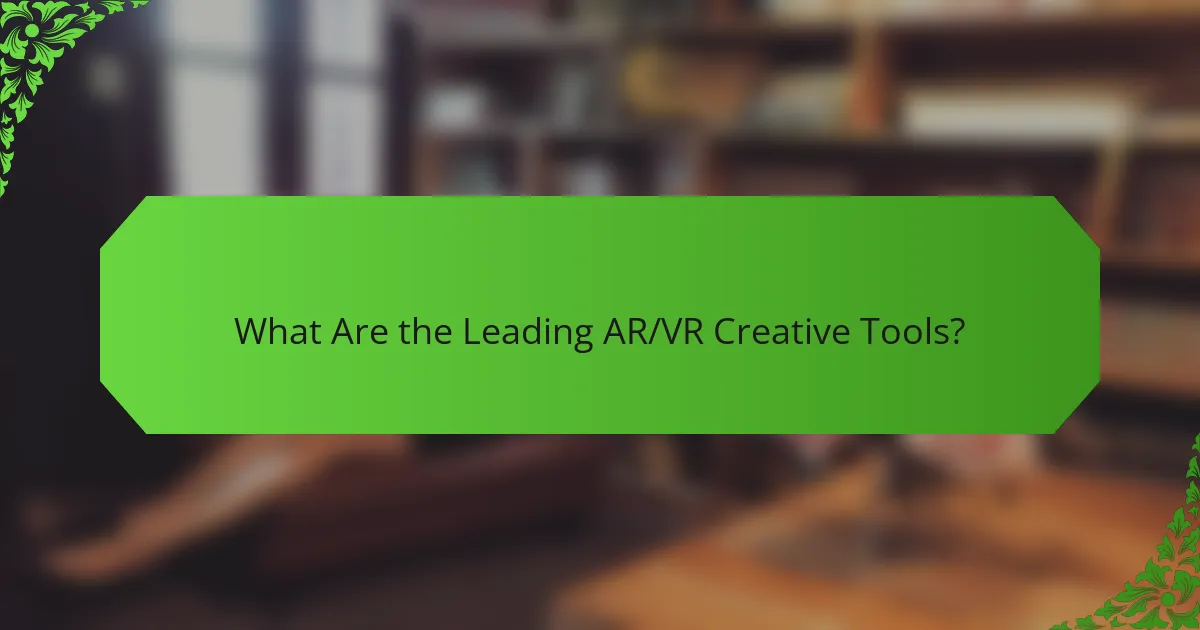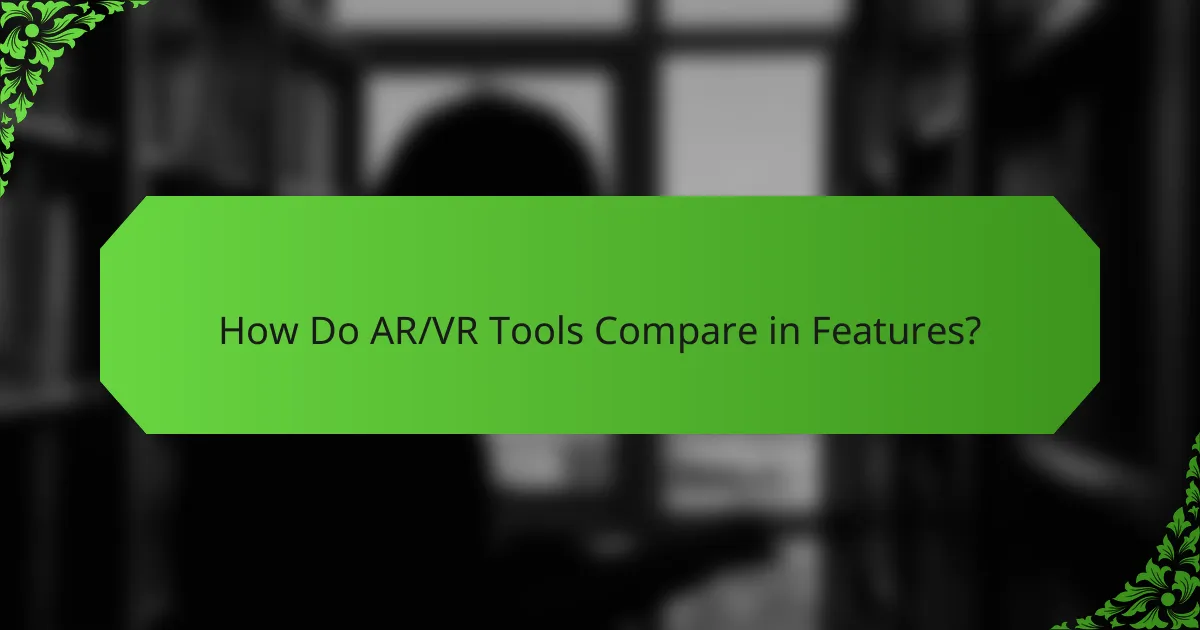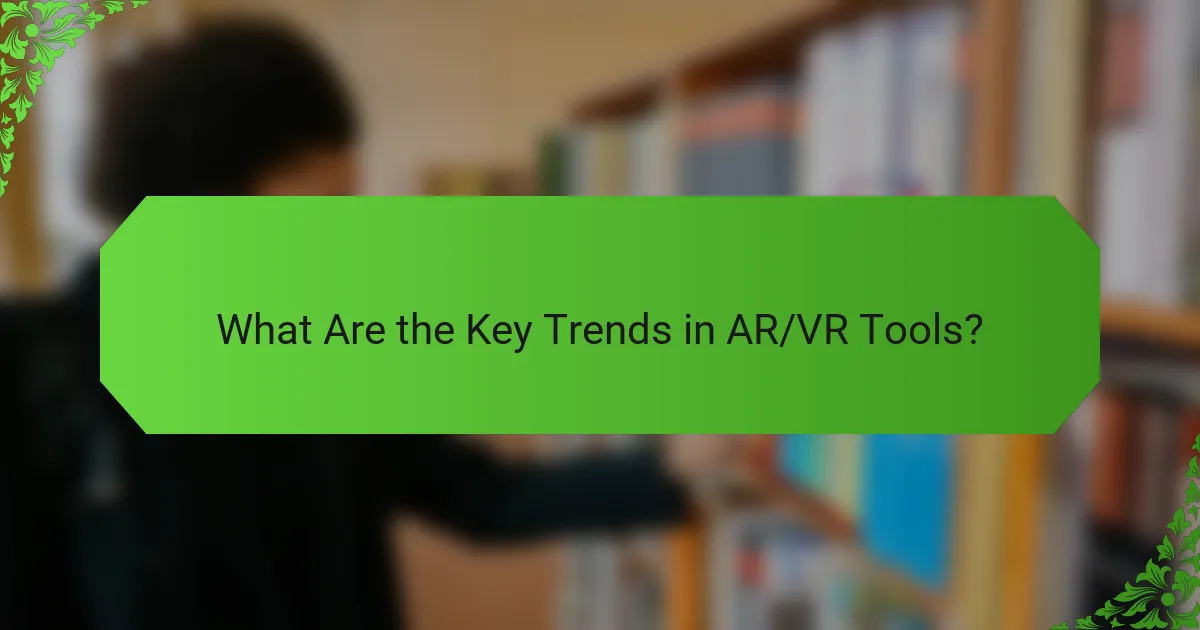As the demand for immersive experiences grows, AR and VR creative tools have emerged as essential resources for creators. This comparison explores the features and pricing of popular options like Adobe Aero, Unity, Blender, Sketchfab, and Oculus Medium, highlighting their unique capabilities and how they cater to different creative needs. Understanding the variations in usability, collaboration, and pricing models will help users make informed decisions when selecting the right tool for their projects.

What Are the Best AR/VR Creative Tools?
The best AR/VR creative tools combine user-friendly interfaces with powerful features, enabling creators to design immersive experiences. Key options include Adobe Aero, Unity, Blender, Sketchfab, and Oculus Medium, each offering unique capabilities and pricing structures to suit different needs.
Adobe Aero
Adobe Aero is a user-friendly tool designed for creating augmented reality experiences without needing extensive coding skills. It allows users to import assets from other Adobe applications and easily animate them in a 3D space.
Pricing for Adobe Aero is included with Adobe Creative Cloud subscriptions, which typically range from $20 to $80 per month depending on the plan. This makes it accessible for both individual creators and teams looking to integrate AR into their projects.
Unity
Unity is a powerful game development platform widely used for creating both AR and VR applications. It offers extensive features, including a robust asset store and support for various platforms, making it suitable for professional developers.
Unity operates on a freemium model, with a free version available for smaller projects and paid plans starting around $40 per month for teams generating over $100,000 annually. This flexibility allows users to scale their usage based on project needs.
Blender
Blender is an open-source 3D modeling tool that supports AR and VR content creation. It offers a comprehensive suite of features for modeling, animation, and rendering, making it ideal for artists and developers alike.
As a free tool, Blender is particularly appealing for budget-conscious creators. However, users may need to invest time in learning its complex interface and features to fully leverage its capabilities.
Sketchfab
Sketchfab is a platform for publishing, sharing, and discovering 3D content, including AR and VR models. It allows users to upload their creations and view them in real-time, making it a great tool for showcasing work.
Sketchfab offers a free tier with basic features, while premium plans start at around $15 per month, providing additional functionalities like higher upload limits and advanced analytics. This tiered pricing makes it accessible for various users, from hobbyists to professionals.
Oculus Medium
Oculus Medium is a VR sculpting tool that enables users to create 3D models in a virtual environment. It offers intuitive hand-tracking and a variety of sculpting tools, making it ideal for artists looking to create immersive content.
Available exclusively for Oculus VR headsets, Oculus Medium is free to use, but users must invest in the hardware. This can be a significant consideration, as Oculus headsets typically range from $300 to $500, depending on the model.

How Do AR/VR Tools Compare in Features?
AR and VR tools vary significantly in features, impacting usability and project outcomes. Key areas of comparison include collaboration capabilities, asset libraries, integration options, and user interface design.
Collaboration Features
Collaboration features in AR and VR tools enable multiple users to work together in real-time, enhancing creativity and efficiency. Look for tools that support simultaneous editing and allow for easy sharing of projects.
Some platforms offer built-in chat or video conferencing, which can facilitate communication during collaborative sessions. Consider tools that provide version control to track changes made by different users, ensuring a smooth workflow.
Asset Libraries
Asset libraries are crucial for AR and VR development, providing pre-made models, textures, and animations. A robust library can save time and resources, allowing creators to focus on design rather than asset creation.
Evaluate the size and variety of the asset library, as well as the licensing terms. Some tools offer free assets, while others may require purchasing or subscription fees for premium content.
Integration Capabilities
Integration capabilities determine how well AR and VR tools can connect with other software and platforms. Look for tools that support popular game engines, design software, and cloud services to streamline your workflow.
Consider whether the tool allows for easy import/export of files and compatibility with existing systems. Strong integration options can enhance productivity by reducing the need for manual data transfers.
User Interface Design
User interface design plays a vital role in the usability of AR and VR tools. A well-designed interface should be intuitive, allowing users to navigate features without extensive training.
Evaluate the layout, accessibility of tools, and customization options. Tools with drag-and-drop functionality or customizable dashboards can significantly improve user experience, especially for beginners.

What Are the Pricing Models for AR/VR Tools?
The pricing models for AR/VR tools vary significantly, impacting how users access and pay for these technologies. The most common models include subscription pricing, one-time purchases, and freemium options, each with its own advantages and considerations.
Subscription Pricing
Subscription pricing involves paying a recurring fee, typically monthly or annually, to access AR/VR tools. This model often includes regular updates and customer support, making it appealing for businesses that require ongoing access to the latest features.
Costs can range from around $10 to several hundred dollars per month, depending on the tool’s capabilities and the level of service provided. Users should evaluate their usage frequency and budget to determine if a subscription is the best fit.
One-Time Purchase
One-time purchase models allow users to buy AR/VR tools outright, providing permanent access without ongoing fees. This can be cost-effective for individuals or organizations that plan to use the software long-term without needing frequent updates.
Prices for one-time purchases can vary widely, often falling between $50 and $1,000 or more, depending on the complexity and functionality of the tool. Consider the potential need for future updates or additional features when opting for this model.
Freemium Options
Freemium options provide basic access to AR/VR tools at no cost, with the option to pay for premium features or additional content. This model is beneficial for users who want to test the software before committing financially.
While many freemium tools are available, users should be aware that the free versions may have limitations, such as reduced functionality or ads. It’s essential to assess whether the free features meet your needs or if upgrading is necessary for full functionality.

How to Choose the Right AR/VR Tool for Your Needs?
Choosing the right AR/VR tool involves assessing your specific project requirements, budget constraints, and the skill level of your team. Understanding these factors will help you select a tool that aligns with your goals and resources.
Project Requirements
Begin by clearly defining the objectives of your AR/VR project. Consider the type of content you want to create, whether it’s immersive experiences, simulations, or interactive training modules. Each tool has unique features that cater to different project types, so ensure the tool you choose supports your specific needs.
For example, if you are developing a training application, look for tools that offer robust analytics and user tracking capabilities. If your focus is on gaming, prioritize tools with strong graphics rendering and user interface design options.
Budget Considerations
Your budget is a critical factor in selecting an AR/VR tool. Prices can vary significantly, with some tools available for free while others may require subscriptions or one-time purchases ranging from hundreds to thousands of dollars. Assess not only the upfront costs but also any ongoing fees for updates or support.
Consider the total cost of ownership, including hardware requirements, which can add to your expenses. For instance, high-end VR tools may necessitate powerful computers or headsets, which can increase your overall investment.
User Skill Level
The skill level of your team will influence the choice of AR/VR tools. If your team has limited experience, opt for user-friendly platforms that offer tutorials and support. Tools with drag-and-drop interfaces can significantly reduce the learning curve.
Conversely, if you have a skilled team, you might benefit from more advanced tools that offer greater customization and flexibility. Evaluate the available resources for training and support to ensure your team can effectively utilize the chosen tool.